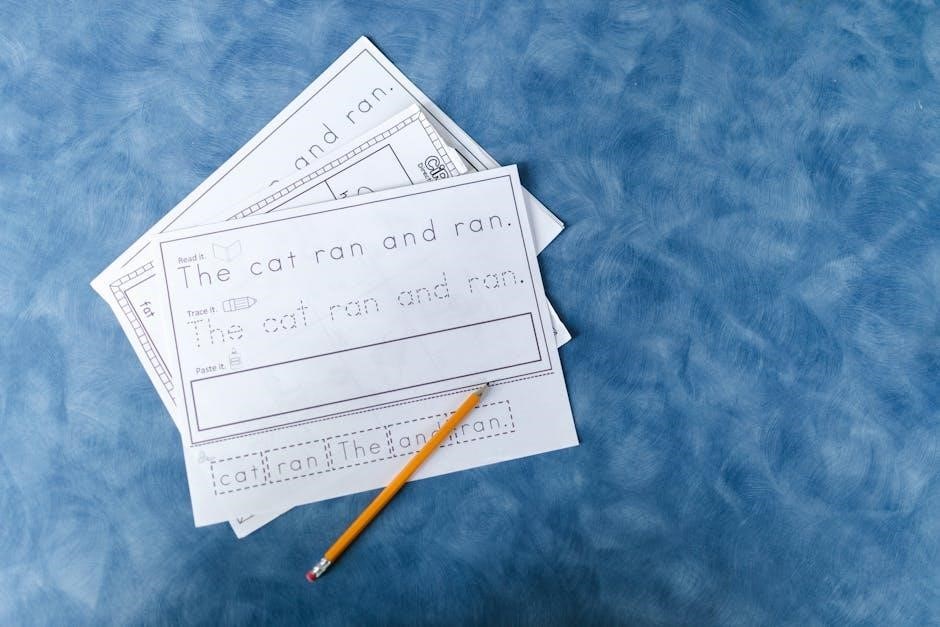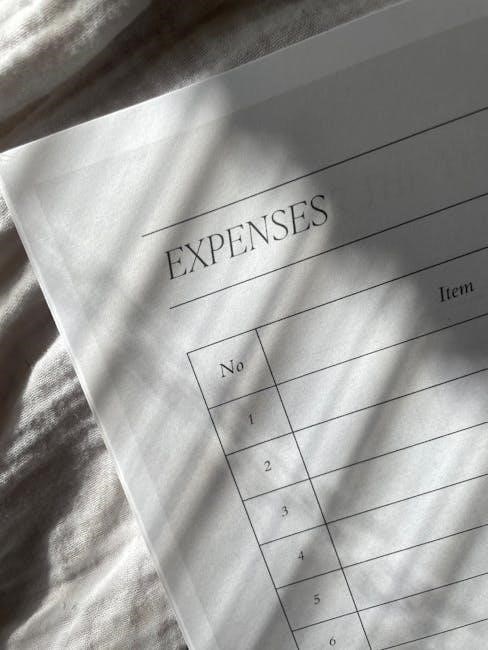Mastering fraction operations is essential for math proficiency. Adding and subtracting fractions requires understanding denominators and numerators. Worksheets offer structured practice, enhancing problem-solving skills and confidence in handling fractions.
Understanding the Basics of Fractions
Fractions represent parts of a whole, with the numerator indicating the part and the denominator the whole. To add or subtract fractions, they must have the same denominator, simplifying calculations. Worksheets provide clear examples and exercises to practice these concepts, ensuring a solid foundation for more complex operations. Visual tools like bar models help students grasp fraction relationships, making learning intuitive and effective.
Importance of Worksheets in Learning Fraction Operations
Importance of Worksheets in Learning Fraction Operations
Worksheets are invaluable for mastering fraction operations, offering structured practice and clear examples. They help students grasp concepts like equivalent fractions and reducing, building confidence. Visual tools, such as bar models, enhance understanding. Worksheets cater to different skill levels, providing exercises for both common and unlike denominators. Regular practice with these resources improves problem-solving skills and ensures a strong foundation in fraction operations, making complex math tasks more approachable.

How to Add Fractions with Common Denominators
Adding fractions with common denominators involves adding the numerators while keeping the denominator the same. Simplify the result if possible. For example, 1/4 + 1/4 equals 2/4, which simplifies to 1/2. This straightforward method ensures accurate results in fraction addition.
Step-by-Step Guide to Adding Fractions
To add fractions with common denominators, ensure the denominators are the same. Next, add the numerators while keeping the denominator unchanged. Simplify the fraction if possible. For example, 1/4 + 1/4 equals 2/4, which simplifies to 1/2. Always check if the result can be reduced further. This method ensures accuracy and provides a clear understanding of fraction addition.
Examples of Adding Fractions with Common Denominators
Adding fractions with common denominators involves adding the numerators while keeping the denominator the same. For example:
- 1/4 + 1/4 = 2/4 = 1/2
- 3/8 + 2/8 = 5/8
- 5/10 + 3/10 = 8/10 = 4/5
- 7/10 + 5/10 = 12/10 = 6/5 or 1 1/5
- 9/12 + 4/12 = 13/12 = 1 1/12
- 0/7 + 2/7 = 2/7
- -1/3 + 2/3 = 1/3
- 3/4 + 1/4 = 4/4 = 1
These examples demonstrate how to add fractions with common denominators, simplify the results, and convert improper fractions to mixed numbers when needed.
How to Subtract Fractions with Common Denominators
Subtracting fractions with common denominators involves subtracting numerators while keeping the denominator the same. Ensure denominators match, subtract the numerators, and simplify if needed for accurate results.
Step-by-Step Guide to Subtracting Fractions
Ensure both fractions have the same denominator. If not, find equivalent fractions with a common denominator. 2. Subtract the numerators while keeping the denominator unchanged. 3. Simplify the resulting fraction by dividing the numerator and denominator by their greatest common divisor. 4. If the result is an improper fraction, convert it to a mixed number if required. 5. Use bar models or visual aids to better understand the subtraction process. 6. Practice regularly with worksheets to build confidence and accuracy in fraction operations.
Examples of Subtracting Fractions with Common Denominators
Subtracting fractions with common denominators is straightforward. For example, to subtract ( rac{3}{8} ⸺ rac{1}{8} ), simply subtract the numerators: ( 3 — 1 = 2 ), resulting in ( rac{2}{8} ), which simplifies to ( rac{1}{4} ). Another example: ( rac{5}{12} — rac{2}{12} = rac{3}{12} = rac{1}{4} ). Using bar models or visual representations can help students grasp the concept effectively. Regular practice with worksheets enhances mastery of fraction subtraction.

Adding and Subtracting Fractions with Unlike Denominators
Adding or subtracting fractions with unlike denominators requires finding a common denominator. Convert fractions to equivalents with the common denominator, then perform the operation. For example, to subtract (1/2 — 1/4), convert to (2/4 ⸺ 1/4) = 1/4. This method ensures accurate results when denominators differ.
Finding Equivalent Fractions
Finding equivalent fractions is a fundamental step in adding and subtracting fractions with unlike denominators. To do this, identify the least common denominator (LCD) and multiply both the numerator and denominator of each fraction by the same number to create equivalent fractions. For example, to compare 1/2 and 1/4, convert 1/2 to 2/4. This ensures both fractions have the same denominator, making operations straightforward. Practice worksheets help students master this essential skill.

Practical Exercises for Unlike Denominators
Practical exercises for unlike denominators involve finding common denominators and converting fractions accordingly. Worksheets provide structured problems, such as adding 1/2 and 1/3, guiding students through step-by-step solutions. These exercises enhance understanding of equivalent fractions and simplify operations. PDF resources offer varied exercises, catering to different skill levels, ensuring comprehensive practice and mastery of fraction operations, especially for students needing additional support or challenging problems. Regular practice builds confidence and fluency in handling unlike denominators effectively.

Adding and Subtracting Mixed Numbers
Adding and subtracting mixed numbers involves converting them to improper fractions for easier calculation. Practice worksheets guide students through splitting whole numbers and fractions to ensure accuracy and mastery.
Converting Mixed Numbers to Improper Fractions
Converting mixed numbers to improper fractions simplifies fraction operations. Multiply the whole number by the denominator, add the numerator, and place over the original denominator. For example, 3 1/2 becomes 7/2. This step ensures uniformity in calculations, making addition and subtraction straightforward. Worksheets provide exercises to master this conversion, enhancing accuracy and confidence in handling mixed numbers effectively in various math problems.
Performing Operations on Mixed Numbers
Operations on mixed numbers involve converting them to improper fractions for easier calculation. Add or subtract the numerators, keeping the denominator the same. Afterward, convert the result back to a mixed number if needed. For example, 3 1/2 + 2 1/2 = 6; Worksheets provide ample practice, ensuring mastery of these steps and building confidence in handling mixed number operations effectively in various mathematical scenarios.
Using Bar Models for Visual Learning
Bar models are visual tools that simplify fraction operations by representing parts of a whole. They help students compare, add, and subtract fractions intuitively, enhancing understanding and retention.

Visual Representation of Fractions
Bar models visually represent fractions, making abstract concepts tangible. They use shaded bars to depict parts of a whole, aiding in comparing, adding, and subtracting fractions. By shading corresponding sections, students can easily identify larger or smaller fractions, facilitating subtraction. This hands-on approach enhances understanding and retention, especially for operations with unlike denominators, by providing a clear, relatable method to solve problems.
Applying Bar Models to Solve Problems
Bar models are effective tools for solving fraction problems visually. By shading corresponding sections, students can align denominators and perform operations intuitively. For addition, combine shaded sections; for subtraction, segment bars to compare. This method aids in identifying common denominators and simplifying complex fraction operations, fostering deeper understanding and confidence in solving real-world math challenges through structured, visual practice.

Practice Worksheets for Mastery
Free PDF worksheets offer structured exercises for adding and subtracting fractions, catering to various skill levels. These resources enhance problem-solving skills and provide comprehensive practice for mastery.
Free PDF Resources for Fraction Operations
Free PDF worksheets are available for adding and subtracting fractions, catering to different skill levels. These resources include exercises for grade 6, mixed numbers, and unlike denominators. Structured templates and answer keys provide comprehensive practice, enhancing mastery of fraction operations. Ideal for classroom or self-study, these tools are accessible and user-friendly, offering a variety of problems to reinforce learning.
Structured Worksheets for Different Skill Levels
Worksheets are designed to suit various skill levels, from basic fraction addition to complex operations with unlike denominators. They include step-by-step guides, examples, and practice exercises. Advanced sheets cover mixed numbers and algebraic fractions, while simpler ones focus on common denominators. These resources help students progress gradually, building confidence and fluency in fraction operations through targeted practice and clear instructions.
Real-World Applications of Fraction Operations
Fractions are essential in everyday tasks like cooking, construction, and budgeting. They help measure ingredients, calculate materials, and manage finances accurately, making them a vital skill for practical problem-solving.
Using Fractions in Everyday Scenarios
Fractions play a crucial role in daily activities like cooking, where recipes require precise measurements. For instance, halving or quartering ingredients ensures dishes turn out correctly. In construction, fractions are used to calculate materials accurately, preventing waste. Budgeting also relies on fractions to allocate resources effectively. Understanding how to add and subtract fractions simplifies tasks like adjusting recipes or comparing prices, making practical math skills indispensable for everyday problem-solving.
Enhancing Problem-Solving Skills
Mastering fraction operations through worksheets helps develop critical thinking and analytical abilities. Regular practice with adding and subtracting fractions improves logical reasoning and precision. Applying these skills to real-world scenarios, such as measuring ingredients or dividing resources, fosters a deeper understanding of mathematical concepts. Visual tools like bar models further enhance problem-solving by providing a clear, structured approach to fraction operations, making complex problems more manageable and boosting overall math confidence.
Effective use of worksheets and bar models enhances understanding and mastery of fraction operations. Regular practice fosters confidence and proficiency, making continued learning enjoyable and successful.
Mastering fraction operations involves understanding common denominators, equivalent fractions, and mixed numbers. Worksheets provide structured practice, while bar models offer visual learning. Adding and subtracting fractions requires matching denominators, simplifying results, and converting mixed numbers to improper fractions. Regular practice with PDF resources enhances problem-solving skills and builds confidence. These concepts form the foundation for advanced math, making consistent practice essential for long-term success and real-world application.

Encouraging Continuous Practice
Consistent practice is vital for mastering fraction operations. Utilize PDF worksheets and online tools to reinforce skills. Regular exercises help build confidence and fluency. Incorporate real-world scenarios to make learning engaging. Encourage problem-solving with bar models and mixed numbers. Structured practice, especially with unlike denominators, ensures a strong foundation. Make practice a routine to enhance understanding and retention of fraction concepts for long-term math success.